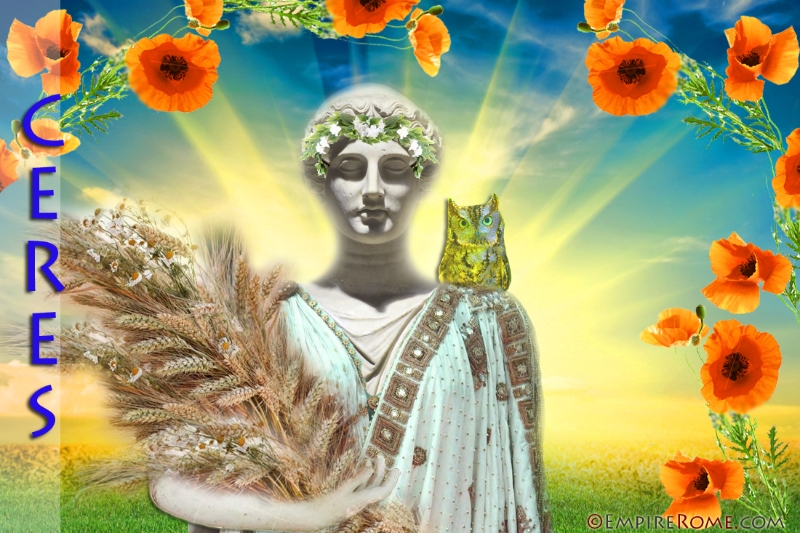
| CERES “Goddess of the Earth” | |
| God of: | Crops, agriculture, fertility, motherly relationships, growing plants, the love that a motherly relationships, rites of the dead, law, and renewal. |
| Type: | Major |
| Roman Name: | Ceres |
| Greek Name: | Demeter |
| Other Names: | |
| Festivals: | Cerealia April 12-19, May Festival of Ambarvalia |
| Shrine/Temple: | Paestum, Temple of Ceres |
Overview
Ceres is the goddess of the earth, fertility, marriage, and agriculture. She is equivalent to the Greek goddess Demeter. According to Ancient Roman mythology, she is also responsible for growing plants, the love that a mother bears for her children, and renewal. Many depictions and statues show her carrying bundles of grain and harvests. It is believed that when Ceres is sad that the crops and plants die, and when she is happy, crops are plentiful and in bloom.
Ceres is the sister of Jupiter, Neptune, Pluto, Vesta, and Juno and mother of Proserpina. Jupiter is also the father of Cere’s daughter Proserpina.
Duties, Attributes, and Symbols
Ceres is associated with spelt, a grain she is celebrated with finding. Ceres is attributed to giving man the knowledge and seeds to grow their own crops so they did not have to wander and go where the food was, rather they could settle down and farm.
Ceres is also associated with a sacrificial bowl and the finding of cereal, hence the name. The conical headdress, torch, and scepter are also credited to Ceres. Animals sacred to Ceres include the pig, dove, screech owl, serpent, and lizard. Since Ceres was goddess of the earth, she held most plants and flowers sacred but more specifically, were poppies, wheat, spelt, barley, corn, and mint.
Mythology
Ancient Roman Mythology tells of the reason for the seasonal change from the beautiful and fertile spring and summer to the harsh and desolate fall and winter. As the story goes, Cere’s daughter Proserpina/Proserpine (Persephone) was in a field gathering flowers one day when her beauty captured the attention of Pluto, god of the Underworld. Pluto had been struck with one of cupids arrows and instantly fell in love with Proserpina. Pluto came on his chariot of horses and kidnaped Proserpina and took her to the Underworld to live with him.
Ceres searched high and low for Proserpina but could not find her anywhere on the Earth. Sad and angry, Ceres stopped the growth of all of crops and plants which meant that mortals would not have any food to eat. Without humans, there would be no one to glorify the gods, and this made Zeus, king of the gods, very worried. Zeus sent his son, Mercury, messenger of the gods, to have Pluto free Proserpina so that Ceres would resume growing food for the people.
Pluto, being clever, knew that Proserpina could not return to the living Earth if she had eaten the food of the Underworld. Pluto gave her six pomegranate seeds to eat. Because Mercury knew of this rule, they made a deal that Proserpina would return to Earth with her mother Ceres six months out of the year and live in the underworld six months out of the year with her husband Pluto.
So, when Proserpina returns to Earth to meet Ceres, Ceres prepares for her return and welcomes her by having the flowers and crops bloom. But when Proserpina must return to Pluto in the Underworld, Ceres is sad and the flowers and crops wither and die. This story helps describe the seasonal changes in Ancient Rome.
Dii Consentes & the Triune
Ceres’ importance and power appeared throughout Ancient Roman history. This is seen with her position in the Dii Consentes, her power in the triune, and with her use of several minor gods.
The Dii Consentes was The Roman Council of twelve Gods/Twelve Great Roman gods and their equals: In Roman mythology the Dii Consentes was made up of six pairs, male and female. It is said to be the equivalent of the 12 Greek Olympian gods. Ceres was coupled with Mercury, “messenger of the gods,” in the Dii Consentes. Ceres was one of the most important and powerful of this group.
The Roman goddess Ceres is also represented as a triune. This means she was one part of a group that made up three persons. Her other two counterparts, or persons in the triune, were Liber and Libera—who were also agriculture gods. In addition, Ceres had an entourage of twelve minor gods who assisted her in her agricultural duties. These twelve minor gods who helped Ceres meet her obligations during the harvest were:
Conditor – who stores the harvest
Conuector – who transports and carts the harvest
Imporcitor – who plows wide trenches in the farm land
Insitor – who plants seeds in the land
Messor – who harvests
Occator – who is responsible for smoothening and setting the soil
Obarator – who plows the surface of the soil
Promitor – who distributes the harvest around Ancient Rome
Reparator – who is responsible for plowing the land
Sarritor – who removes weeds from the land
Subruncinator – who thins out the land
Vervartor – who turns the land
Festivals and Worship
Cere’s holy festival is called Cerealia which honors the goddess of grain, celebrated during mid to late April for several days. Ambarvalia is another celebration that honors Ceres, it is held towards the end of May. During this celebration, in Cere’s honor, Ancient Romans sacrificed bulls, sows, and sheep after they grazed around in fields. Sacrifices were common in Ancient Rome because it was a way the Ancient Romans could show gratitude to their deities. Many times throughout ancient history, gods and goddesses were established and adopted because of an apparent event. It was believed that Ceres became more popular after Rome had experienced a famine around 496 BC.
Fun Facts
It is believed that the word cereal came from the Ancient Roman goddess Ceres. Because she was the goddess of agriculture and crops, it is believed that this popular breakfast food is named after her.
Today the Ancient Roman goddess Ceres has been adopted by the scientific community. Scientists named a small planet in our asteroid belt after her that was discovered in 1801. The planet Ceres is the largest and most massive object in the asteroid belt between the inner and outer planets.
Scientists also named a chemical element called cerium after the Ancient Roman Goddess Ceres. Cerium (Ce) is a type of ductile metal that is abundant in the Earths’ crust. Cerium is a light silvery color and is used in many marketable applications. It is most notably used in fluorescent lamps and a component to change the color of glass. In addition, Cerium compounds are used to lessen emissions in diesel fuels.
Click here to return to Ancient Roman Gods and Goddesses list.

